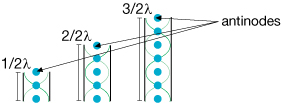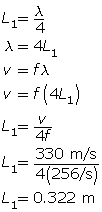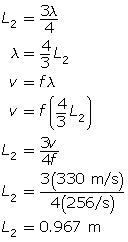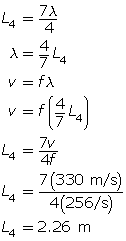Module 8—Mechanical Waves
Open-air Column Resonance
If the air column is open on both ends, resonance will only be heard when the air column is a multiple of ½ of the standing wavelength, as shown below.

Open-air column resonance is heard when an antinode exists at both openings of the air column. This occurs when the air column is ![]() and so on. Expressed as an equation, it is
and so on. Expressed as an equation, it is ![]() and so on.
and so on.
Quantity |
Symbol |
SI Unit |
length |
L |
m |
wavelength |
λ |
m |
 Read
Read
How is this equation used in calculations? Read “Resonating Air Columns” on pages 418 to 420 of your physics textbook.
 Self-Check
Self-Check
SC 1. Complete question 2 of “Practice Problems” on page 420 of your textbook.
 Self-Check Answers
Self-Check Answers
SC 1.
Given
f = 256 Hz
v = 330 m/s
Required
the length of the air column for the first four resonance positions (L1, L2, L3, and L4)
Analysis and Solution
The length of the air column for the first four resonance positions will occur at ![]()




Paraphrase
The length of the air column for the first four resonance positions will occur at 0.322 m, 0.967 m, 1.61 m, and 2.26 m.
 Module 8: Lesson 4 Assignment
Module 8: Lesson 4 Assignment
Remember to submit the answers to TR 1, TR 2, and TR 3 to your teacher as part of your Module 8: Lesson 4 Assignment.
 Try This
Try This
TR 1. A tuning fork of frequency 440 Hz is held above an air column that is gradually increased in length. What is the length of the air column that will produce the second resonance position when the speed of sound is 336 m/s?
TR 2. What is the speed of sound where a tuning fork of frequency 262 Hz produces the third resonance position above an air column that is 1.59 m in length?
TR 3. The speed of sound is 340 m/s where a tuning fork produces the second resonance position above an air column that is 49.8 cm in length. What is the frequency of the tuning fork?
 Read
Read
Musical instruments sound much richer than tuning forks. Read “Music and Resonance” on pages 422 to 424 of your physics textbook.
 Self-Check
Self-Check
SC 2. The speed of sound varies with changes in air pressure and temperature. To get the correct fundamental frequency, musical instruments must be tuned. Explain how the adjustment to tune stringed instruments is different than the adjustment to tune wind instruments.
 Self-Check Answers
Self-Check Answers
SC 2. Stringed instruments are tuned by adjusting the tension in the strings, but wind instruments are tuned by adjusting the length of the pipe.
 Watch and Listen
Watch and Listen
Use this Standing Longitudinal Waves to explore both open- and closed-air column resonance.
 Self-Check
Self-Check
SC 3. To check your understanding of superposition and interference for waves in air columns, use the Standing Longitudinal Waves applet to answer the following questions:
- Choose “both sides open.” Then select “Higher” vibrational mode twice to get the second overtone. For the second overtone when a tube that has both sides open, how many wavelengths is the length of the tube?
- Choose “one side open.” Then select “Higher” vibrational mode until you get the third overtone. For the third overtone when a tube that has one side open, how many wavelengths is the length of the tube?
 Self-Check Answers
Self-Check Answers
SC 3.
 Module 8: Lesson 4 Assignment
Module 8: Lesson 4 Assignment
Remember to submit the answer to TR 4 to your teacher as part of your Module 8: Lesson 4 Assignment.
 Try This
Try This
TR 4. Use the Standing Longitudinal Waves applet to answer the following questions:
- For the third overtone when a tube that has both sides open, how many wavelengths is the length of the tube?
- For the first overtone when a tube that has one side open, how many wavelengths is the length of the tube?